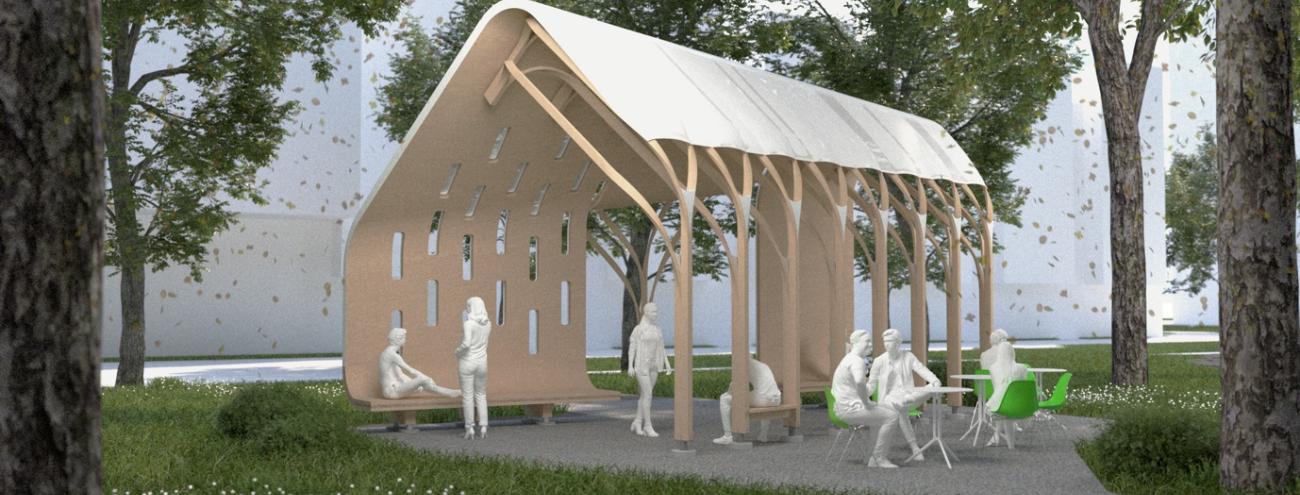
Interview: Blair, Carole and Steven, Co-Leads for the Outdoor Learning Space Project
UBC's Outdoor Learning Space project was born out of the need to create a space where students could gather and learn outdoors during the pandemic. The project is a collaboration between the Alma Mater Society, Campus and Community Planning, and the School of Architecture and Landscape Architecture (SALA). We spoke with Carole Jolly, Director of Community Development and Transportation at Campus and Community Planning; Blair Satterfield, Chair of the architecture program at SALA and Founder and Director of the HiLo Lab; and Graham Entwistle, Workshop Technician at SALA.
Q: What interested you in this project?
Carole: The project was an initiative led by the Alma Mater Society, as part of their grad class gift initiative. The AMS was interested in finding ways to support student outdoor learning and gathering spaces. We invited SALA into the discussion and together explored all the interests, and opportunities. From there, the project was born.
Blair: The project was a natural fit for the HiLo Lab and a chance to externalize our research and apply it in the public realm. The project is also a fantastic opportunity to contribute to the campus environment.
Graham: I was fascinated by the opportunity to apply both material research and performance research from architecture to help and commemorate this beautiful idea that these students had. It was an incredibly optimistic thing, and I was delighted to be part of it.
Q: How does this project fit into UBC's overall planning framework?
Carole: UBC’s Land Use Plan provides the overarching framework through policies and objectives that guide planning, land use management, and long-term development plans. The Vancouver Campus Plan guides how academic facilities, student housing, transportation systems, green and open space, and community amenities are accommodated across the academic lands. The Public Realm Plan, is an implementation tool of the Vancouver Campus Plan, and provides guidance for how principles and policies for outdoor space can be put into action. This includes animation and activation objectives for our outdoor spaces on campus, which is essential to the experience of this place. We've learned a lot over the years about what students value, and that what happens outside the classroom is equally important to the student experience, including opportunities for social connection and community building.
Q: What are the collaborative synergies behind this project?
Carole: The AMS initiative is being supported through the efforts of SALA, and their design build course, work, research, and technology. We all are interested in seeing this project be as successful as possible. Our dialogues have been very collaborative, focused on constructive problem-solving, and opportunities to ensure this project can move forward as successfully as possible.
Blair: The HiLo lab is the project's design lead, fabrication lead, and ultimately the construction lead. We will also be prototyping elements for the project and conducting material testing. These are things that Graham contributes to and our shop colleagues support. The team will generate and deliver building components to the site. To achieve our goals we will need to work with members of the SALA and UBC community, including people in Building Operations and other departments.
Q: What impact do you hope this project will have?
Blair: We hope that Zippered Wood will ultimately become useful in light-frame construction and wooden building design across North America. We are publishing the project to raise awareness of its potential. We also see the pavilion as a fantastic opportunity to build something beneficial, useful, and welcoming for the UBC community.
Carole: One of the exciting things about this project is seeing how it performs and how people relate to it. And then what that means for how we think about other public realm activation opportunities in the future. We're collecting wisdom from the benefits of these types of interventions and then looking at how we can replicate those opportunities and continue to support our aspirations around a thriving public realm and what it means for people and their connection to these types of spaces.
The Outdoor Learning Space project is a fantastic example of the collaborative and innovative work being done at UBC. It's exciting to see how the project will evolve and impact the campus community and beyond.